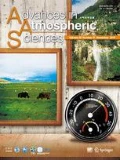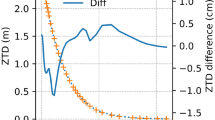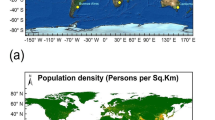Abstract
The North–East Corridor (NEC) Testbed project is the 3rd of three NIST (National Institute of Standards and Technology) greenhouse gas emissions testbeds designed to advance greenhouse gas measurements capabilities. A design approach for a dense observing network combined with atmospheric inversion methodologies is described. The Advanced Research Weather Research and Forecasting Model with the Stochastic Time-Inverted Lagrangian Transport model were used to derive the sensitivity of hypothetical observations to surface greenhouse gas emissions (footprints). Unlike other network design algorithms, an iterative selection algorithm, based on a k-means clustering method, was applied to minimize the similarities between the temporal response of each site and maximize sensitivity to the urban emissions contribution. Once a network was selected, a synthetic inversion Bayesian Kalman filter was used to evaluate observing system performance. We present the performances of various measurement network configurations consisting of differing numbers of towers and tower locations. Results show that an overly spatially compact network has decreased spatial coverage, as the spatial information added per site is then suboptimal as to cover the largest possible area, whilst networks dispersed too broadly lose capabilities of constraining flux uncertainties. In addition, we explore the possibility of using a very high density network of lower cost and performance sensors characterized by larger uncertainties and temporal drift. Analysis convergence is faster with a large number of observing locations, reducing the response time of the filter. Larger uncertainties in the observations implies lower values of uncertainty reduction. On the other hand, the drift is a bias in nature, which is added to the observations and, therefore, biasing the retrieved fluxes.
摘要
东北走廊(NEC, North-East Corridor)测试平台项目是美国国家标准与技术研究所(NIST, National Institute of Standards and Technology)的第三个温室气体排放源测试平台. 本项目旨在提高温室气体测量能力. 本文介绍了这个项目的与大气反演方法相结合的密集观测网络的设计方法. 这种方法应用 WRF(ARW 版本) 模式(Advanced ResearchWeather Research and Forecasting Model)与STILT模式(Stochastic Time-Inverted Lagrangian Transport model)相耦合来计算假定的观测对地表温室气体排放源的敏感性(足迹). 和其他观测网的设计算法的不同之处在于, 这个密集观测网络应用一个基于 k-means 聚类方法的迭代挑选算法, 以最小化每个站点的时间响应之间的相似性, 并最大化城市排放源贡献的敏感性. 一旦选择了某种配置的观测网, 将使用综合反演贝叶斯卡尔曼滤波来评估它的性能. 我们展示了由不同数量的塔和不同的位置的塔组成的不同配置的多个观测网的性能. 结果表明, 由于附加到每个站点的空间信息不能最理想的覆盖最大可能的区域, 过度密集的观测网的空间覆盖范围会减小, 而过度分散的观测网则会失去约束通量不确定性的能力. 此外, 我们还探讨了使用带有较低成本和具有较大不确定性和时间偏移的性能传感器的高密度网络的可能性. 当观测站点较多时, 分析收敛速度变快, 减少了滤波的响应时间. 观测中的较大不确定性意味着较少的不确定性的减少值. 另一方面, 自然界中存在的偏差被带入到观测中, 从而使得反演通量有偏差.
Similar content being viewed by others
References
Bréon, F. M., and Coauthors, 2015: An attempt at estimating Paris area CO2 emissions from atmospheric concentration measurements. Atmos. Chem. Phys, 15, 1707–1724.
Brioude, J., and Coauthors, 2012: A new inversion method to calculate emission inventories without a prior at mesoscale: Application to the anthropogenic CO2 emission from Houston, Texas. J. Geophys. Res., 117(D5), D05312, doi: 10.1029/2011JD016918.
Cambaliza, M. O. L., and Coauthors, 2014: Assessment of uncertainties of an aircraft-based mass balance approach for quantifying urban greenhouse gas emissions. Atmos. Chem. Phys., 14, 9029–9050.
Coniglio, M. C., J. Correia, P. T. Marsh, and F. Y. Kong, 2013: Verification of convection-allowing WRF model forecasts of the planetary boundary layer using sounding observations. Wea. Forecasting, 28, 842–862.
Duren, R. M., and C. E. Miller, 2012: Measuring the carbon emissions of megacities. Nature Clim. Change, 2, 560–562.
Forgy, E. W., 1965: Cluster analysis of multivariate data: Efficiency versus interpretability of classifications. Biometrics, 21, 768–769.
Gerbig, C., J. C. Lin, S. C. Wofsy, B. C. Daube, A. E. Andrews, B. B. Stephens, P. S. Bakwin, and C. A. Grainger, 2003: Toward constraining regional-scale fluxes of CO2 with atmospheric observations over a continent: 2.Analysis of COBRA data using a receptor-oriented framework. J. Geophys. Res., 108(D24): 4757.
Hartigan, J. A., and M. A. Wong, 1979: Algorithm AS 136: A Kmeans clustering algorithm. Applied Statistics, 28, 100–108.
Hungershoefer, K., F.-M. Breon, P. Peylin, F. Chevallier, P. Rayner, A. Klonecki, S. Houweling, and J. Marshall, 2010: Evaluation of various observing systems for the global monitoring of CO2 surface fluxes, Atmos. Chem. Phys., 10, 10503–10520.
IPCC, 2013: Climate Change 2013: The Physical Science Basis. Working Group I Contribution to the Fifth Assessment Report of the Intergovernmental Panel on Climate Change. Stocker et al., Eds., Cambridge University Press, Cambridge, 1552 pp.
Janjic, Z. I., 1994: The step-mountain Eta coordinate model: Further developments of the convection, viscous sublayer, and turbulence closure schemes. Mon. Wea. Rev., 122, 927–945.
Kain, J. S., 2004: The Kain-Fritsch convective parameterization: An update. J. Appl. Meteor., 43, 170–181.
Kort, E. A., W. M. Angevine, R. Duren, and C. E. Miller, 2013: Surface observations for monitoring urban fossil fuel CO2 emissions: Minimum site location requirements for the Los Angeles Megacity. J. Geophys. Res., 118, 1577–1584.
Lauvaux, T., A. E. Schuh, M. Bocquet, L. Wu, S. Richardson, N. Miles, and K. J. Davis, 2012: Network design for mesoscale inversions of CO2 sources and sinks. Tellus B, 64, 17980.
Lauvaux, T., and Coauthors, 2016: High-resolution atmospheric inversion of urban CO2 emissions during the dormant season of the Indianapolis Flux Experiment (INFLUX). J. Geophys. Res., 121, 5213–5236.
Lin, J. C., C. Gerbig, S. C. Wofsy, A. E. Andrews, B. C. Daube, K. J. Davis, and C. A. Grainger, 2003: A near-field tool for simulating the upstream influence of atmospheric observations: The Stochastic Time-Inverted Lagrangian Transport (STILT) model. J. Geophys. Res., 108(D16), 4493.
Lorenc, A. C., 1986: Analysis methods for numerical weather prediction. Quart. J. Roy. Meteor. Soc., 112: 1177–1194.
Loveland, T. R., and A. S. Belward, 1997: The IGBP-DIS global 1km land cover data set, DISCover: First results. Int. J. Remote Sens., 18, 3289–3295.
McKain, K., S. C. Wofsy, T. Nehrkorn, J. Eluszkiewicz, J. R. Ehleringer, and B. B. Stephens, 2012: Assessment of groundbased atmospheric observations for verification of greenhouse gas emissions from an urban region. Proceedings of the National Academy of Sciences of the United States of America, 109, 8423–8428.
Mellor, G. L., and T. Yamada, 1982: Development of a turbulence closure model for geophysical fluid problems. Rev. Geophys., 20, 851–875.
Mlawer, E. J., S. J. Taubman, P. D. Brown, M. J. Iacono, and S. A. Clough, 1997: Radiative transfer for inhomogeneous atmospheres: RRTM, a validated correlated-k model for the longwave. J. Geophys. Res., 102(D14): 16663–16682.
Mueller, K. L., S. M. Gourdji, and A. M. Michalak, 2008: Global monthly averaged CO2 fluxes recovered using a geostatistical inverse modeling approach: 1. Results using atmospheric measurements. J. Geophys. Res., 113(D21): D21114.
Nakanishi, M., and H. Niino, 2006: An improved Mellor-Yamada Level-3 model: Its numerical stability and application to a regional prediction of advection fog. Bound.-Layer Meteor., 119, 397–407.
Nehrkorn, T., J. Eluszkiewicz, S. C. Wofsy, J. C. Lin, C. Gerbig, M. Longo, and S. Freitas, 2010: Coupled weather research and forecasting-stochastic time-inverted Lagrangian transport (WRF-STILT) model. Meteor. Atmos. Phys., 107, 51–64.
Patil, M. N., R. T. Waghmare, S. Halder, and T. Dharmaraj, 2011: Performance of Noah land surface model over the tropical semi-arid conditions in western India. Atmos. Res., 99, 85–96.
Rosenzweig, C., W. Solecki, S. A. Hammer, and S. Mehrotra, 2010: Cities lead the way in climate-change action. Nature, 467, 909–911.
Ruiz-Arias, J. A., J. Dudhia, F. J. Santos-Alamillos, and D. Pozo-Vázquez, 2013: Surface clear-sky shortwave radiative closure intercomparisons in the Weather Research and Forecasting model. J. Geophys. Res., 118, 9901–9913.
Shiga, Y. P., A. M. Michalak, S. Rand olph Kawa, and R. J. Engelen, 2013: In-situ CO2 monitoring network evaluation and design: A criterion based on atmospheric CO2 variability. J. Geophys. Res., 118, 2007–2018.
Skamarock, W. C., and Coauthors, 2008: A description of the advanced research WRF version 3. NCAR Technical Note NCAR/TN-475+STR.
Strahler, A., D. Muchoney, J. Borak, M. Friedl, S. Gopal, E. Lambin, and A. Moody, 1999: MODIS land cover product algorithm theoretical basis document (ATBD) version 5.0: MODIS land cover and land -cover change. USGS, NASA. [Available online from http://modis.gsfc.nasa.gov/data/atbd/atbd mod12.pdf]
Thompson, G., R. M. Rasmussen, and K. Manning, 2004: Explicit forecasts of winter precipitation using an improved bulk microphysics scheme. Part I: Description and sensitivity analysis. Mon. Wea. Rev., 132, 519–542.
Turnbull, J. C., and Coauthors, 2015: Toward quantification and source sector identification of fossil fuel CO2 emissions from an urban area: Results from the INFLUX experiment. J. Geophys. Res., 120, 292–312.
Wu, L., G. Broquet, P. Ciais, V. Bellassen, F. Vogel, F. Chevallier, I. Xueref-Remy, and Y. L. Wang, 2016: What would dense atmospheric observation networks bring to the quantification of city CO2 emissions? Atmos. Chem. Phys., 16, 7743–7771.
Ziehn, T., A. Nickless, P. J. Rayner, R. M. Law, G. Roff, and P. Fraser, 2014: Greenhouse gas network design using backward Lagrangian particle dispersion modelling-Part 1: Methodology and Australian test case. Atmos. Chem. Phys., 14, 9363–9378.
Acknowledgements
The authors would like to thank Dr. Adam PINTAR of the National Institute of Standards and Technology for his insightful comments on the covariance model employed in this work. Funding was provided by the NIST Greenhouse Gas and Climate Science Measurements program. Any opinions, findings and conclusions or recommendations expressed in this material are those of the authors and do not necessarily reflect the views of NIST.
Author information
Authors and Affiliations
Corresponding author
Rights and permissions
About this article
Cite this article
Lopez-Coto, I., Ghosh, S., Prasad, K. et al. Tower-based greenhouse gas measurement network design—The National Institute of Standards and Technology North East Corridor Testbed. Adv. Atmos. Sci. 34, 1095–1105 (2017). https://doi.org/10.1007/s00376-017-6094-6
Received:
Revised:
Accepted:
Published:
Issue Date:
DOI: https://doi.org/10.1007/s00376-017-6094-6




